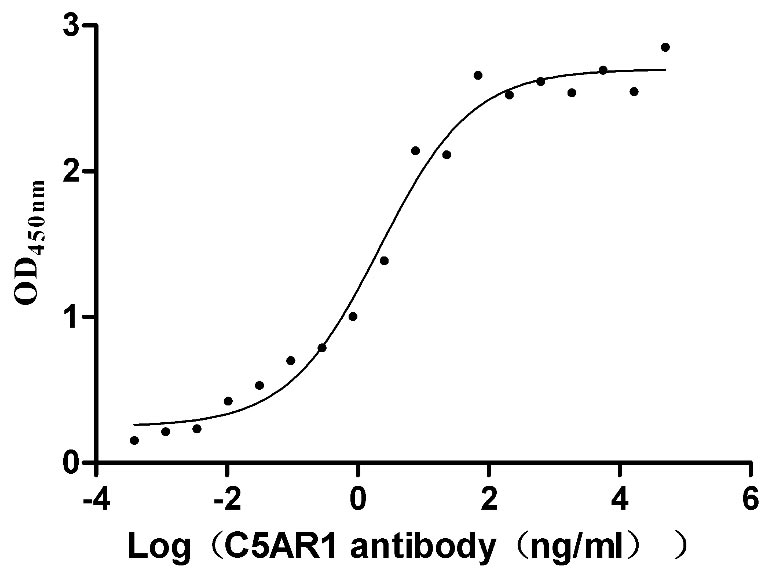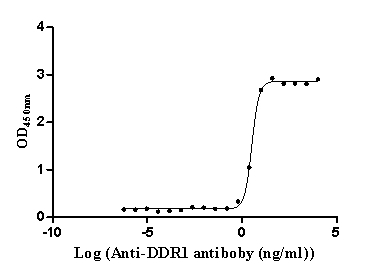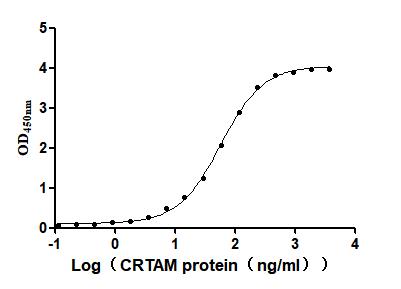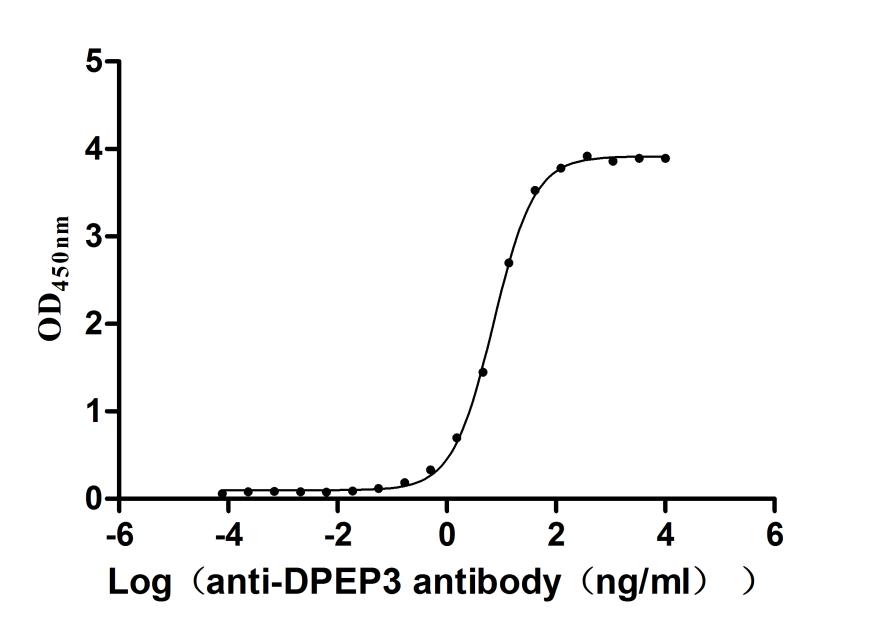Recombinant Human Voltage-gated inwardly rectifying potassium channel KCNH2 (KCNH2 ERG ERG1 HERG)
-
中文名稱:
-
貨號:CSB-EP619634HU-B
-
說明書:
-
規格:
-
來源:E.coli
-
共軛:Avi-tag Biotinylated
E. coli biotin ligase (BirA) is highly specific in covalently attaching biotin to the 15 amino acid AviTag peptide. This recombinant protein was biotinylated in vivo by AviTag-BirA technology, which method is BriA catalyzes amide linkage between the biotin and the specific lysine of the AviTag.
-
其他:
產品詳情
-
純度:>85% (SDS-PAGE)
-
基因名:KCNH2
-
Uniprot No.:
-
別名:Voltage-gated inwardly rectifying potassium channel KCNH2; Eag homolog; Ether-a-go-go-related gene potassium channel 1; ERG-1; Eag-related protein 1; Ether-a-go-go-related protein 1; H-ERG; hERG-1; hERG1; Potassium voltage-gated channel subfamily H member 2; Voltage-gated potassium channel subunit Kv11.1; KCNH2 ERG ERG1 HERG
-
種屬:Homo sapiens (Human)
-
蛋白標簽:Tag?type?will?be?determined?during?the?manufacturing?process.
The tag type will be determined during production process. If you have specified tag type, please tell us and we will develop the specified tag preferentially. -
產品提供形式:Liquid or Lyophilized powder
Note: We will preferentially ship the format that we have in stock, however, if you have any special requirement for the format, please remark your requirement when placing the order, we will prepare according to your demand. -
復溶:We recommend that this vial be briefly centrifuged prior to opening to bring the contents to the bottom. Please reconstitute protein in deionized sterile water to a concentration of 0.1-1.0 mg/mL.We recommend to add 5-50% of glycerol (final concentration) and aliquot for long-term storage at -20℃/-80℃. Our default final concentration of glycerol is 50%. Customers could use it as reference.
-
儲存條件:Store at -20°C/-80°C upon receipt, aliquoting is necessary for mutiple use. Avoid repeated freeze-thaw cycles.
-
保質期:The shelf life is related to many factors, storage state, buffer ingredients, storage temperature and the stability of the protein itself.
Generally, the shelf life of liquid form is 6 months at -20°C/-80°C. The shelf life of lyophilized form is 12 months at -20°C/-80°C. -
貨期:Delivery time may differ from different purchasing way or location, please kindly consult your local distributors for specific delivery time.Note: All of our proteins are default shipped with normal blue ice packs, if you request to ship with dry ice, please communicate with us in advance and extra fees will be charged.
-
注意事項:Repeated freezing and thawing is not recommended. Store working aliquots at 4°C for up to one week.
-
Datasheet :Please contact us to get it.
相關產品
靶點詳情
-
功能:Pore-forming (alpha) subunit of voltage-gated inwardly rectifying potassium channel. Channel properties are modulated by cAMP and subunit assembly. Mediates the rapidly activating component of the delayed rectifying potassium current in heart (IKr).; Has no channel activity by itself, but modulates channel characteristics by forming heterotetramers with other isoforms which are retained intracellularly and undergo ubiquitin-dependent degradation.; Has no channel activity by itself, but modulates channel characteristics by forming heterotetramers with other isoforms which are retained intracellularly and undergo ubiquitin-dependent degradation.
-
基因功能參考文獻:
- Dominant-negative hERG1b G288S subunits suppress hERG1a currents. hERG1a G628S did not produce measurable currents and a mixture of hERG1a and hERG1a G628S markedly reduced hERG1a current PMID: 29089383
- novel variants in SCN5A, KCNH2 and KCNQ1 are associated with congenital long QT syndrome in a Polish population PMID: 30244407
- Data have defined the requirements for the susceptibility of LQT2 mutations to nonsense-mediated mRNA decay (NMD), and suggested that the majority of LQT2 nonsense and frameshift mutations are potential targets of NMD. Given that these specific mutations account for more than 30% of reported LQT2 mutations, the degradation of mutant mRNA by NMD is an important disease causing mechanism in the pathogenesis of LQT2. PMID: 29058182
- Applying the computational approaches in this study, have helped to elucidate the possible binding patterns and time evaluation dynamics of this drug at hERG1 channel models (both in its open and open-inactivated states) together with the crucial amino acid residues that mostly contribute in binding processes via interaction binding energy decomposition analysis. PMID: 28963955
- In a family afflicted by recurrent SIDS, post-mortem directed genetic testing was conducted. We demonstrate that despite the variant being present in both SIDS cases, KCNH2-p.Pro963Thr did not appreciably alter membrane surface expression of the hERG channel, or the biophysical properties, including deactivation gating. These findings suggest that KCNH2-p.Pro963Thr is not a monogenic disease-causing LQTS mutation PMID: 29331839
- It was also found that drug ionization may play a crucial role in preferential targeting to the open-inactivated state of the pore domain. pH-dependent hERG blockade by dofetilie was studied with patch-clamp recordings. The results show that low pH increases the extent and speed of drug-induced block. PMID: 27731415
- Fluconazole can prolong the QT interval and possess proarrhythmic activity due to its inhibition of hERG protein trafficking in experimental model. PMID: 27189953
- Our results underscore the importance of careful characterization of the impact of epitope fusion tags and of confirming complete sequence accuracy prior to genotype-phenotype studies for ion channel proteins such as hERG. PMID: 28544109
- Data show that ether-a-go-go-related 1 (hERG1) ion channel expression knockdown elicited a reversion of the epithelial to the mesenchymal state (EMT) profile in colorectal cancer HCT116 cells with a reacquisition of the epithelial-like profile. PMID: 28593575
- TBX20 can be considered a KCNH2-modifying gene. PMID: 28049825
- The KCNH2 intron 9 branch point is linked to the regulation of KCNH2 isoform expression in cardiomyocytes. PMID: 28433559
- Our findings suggest that the K897T polymorphism of KCNH2 may contribute to the occurrence of syncope in Andersen-Tawil syndrome. PMID: 28336205
- this study shows that hERG1 behaves as biomarker of progression to adenocarcinoma in Barrett's esophagus and can be exploited for a novel endoscopic surveillance PMID: 27517748
- results reveal a novel mechanism by which stimulation of Kv11.1 channel leads to transcription of a potent tumor suppressor and suggest a potential therapeutic use for Kv11.1 channel activators PMID: 25945833
- QTi derived from Holter recordings predicts the mutation carrier state in families with Long QT syndromes. Increased 24-hour QT-RR slope is a diagnostic hint pointing in the direction of LQT2. PMID: 28212739
- The notorious ligand promiscuity of this channel earmarked hERG as one of the most important antitargets to be considered in early stages of drug development process. Herein we report on the development of an innovative and freely accessible web server for early identification of putative hERG blockers and non-blockers in chemical libraries. PMID: 27490970
- structural basis and role of the fast component of gating charge PMID: 29117522
- In HEK293 cells, CO inhibited wild-type, but not C723S mutant, Kv11.1 K(+) currents. Inhibition was prevented by an antioxidant, mitochondrial inhibitors, or inhibition of NO formation. PMID: 28743763
- data provide novel information about hypoxia-mediated hERG dysfunction and may have biological and clinical implications in hypoxia-associated diseases. PMID: 28784631
- Relative expression of Kv11.1 C-terminal isoforms can be regulated by modified U1 snRNA. PMID: 29066300
- Expression and functions of hERG are regulated by specific miRNAs. PMID: 27558843
- The present study shows clinical and genetic aspects of p.His492Tyr carriers and demonstrated two major findings; (1) KCNH2 p.His492Tyr variant presented symptomatic Romano-Ward syndrome in the presence of another LQTS-related gene mutation, in contrast, (2) heterozygous carriers had mild QT prolongation while additional triggers can be "latent" form of p.His492Tyr PMID: 27816319
- Homozygous carriers of CYP2B6*6 allele may be at increased risk for EFV-induced QT interval prolongation via inhibition of hERG. PMID: 27333947
- ER-located J-protein chaperones were identified as key regulators for the iogenesis and physiological function of ERG K+ channels. They regulate two distinct aspects of K+ channel biogenesis, the stabilization and assembly of channel subunits. PMID: 27916661
- atypical sequence of the pore helix of hERG may play a key role in determining how anionic lipids influence its gating PMID: 28314880
- Besides a prolonged cardiac repolarization phase, LQT2 patients display increased GLP-1, GIP, and insulin secretion and defective glucagon secretion, causing decreased plasma glucose and thus increased risk of hypoglycemia. PMID: 28235848
- BIMU8 is a potent blocker of hERG, NaV1.5 and CaV1.2 cardiac ion channels, inducing cardiac arrhythmias. PMID: 28552773
- The K897T polymorphism in the hERG1 gene has been reported as an important modifier of the IKr current, probably leading to QT interval prolongation-as it is observed in the LQT2 syndrome. PMID: 26109178
- Stabilization of the Activated hERG Channel Voltage Sensor by Depolarization Involves the S4-S5 Linker PMID: 28122216
- Study determined the structure of hERG using cryo-electron microscopy; the voltage sensors are depolarized, and the inner helical gate is open; an unusual geometry of the "central cavity" within hERG's ion conduction pathway; hERG contains a subtle difference in the structure of its selectivity filter compared to all other K+ channels so far analyzed. PMID: 28431243
- S1 region mutations would reduce both the action potential repolarizing current passed by Kv11.1 channels in cardiac myocytes, as well as the current passed in response to premature depolarizations that normally helps protect against the formation of ectopic beats. PMID: 28280240
- hERG mediated by proteases such as calpain may contribute to ischemia-associated QT prolongation and sudden cardiac death PMID: 27502273
- the two tyrosine residues in the Kv11.1 S4S5 linker play critical but distinct roles in the slow deactivation phenotype, which is a hallmark of Kv11.1 channels. PMID: 27317659
- Authors found that expression of HERG K(+) channels in MDS patients was significantly higher than controls and was lower than AML. PMID: 27077769
- M3-mAChR activation leads to enhancement of hsp expression via PKC-dependent phosphorylation of HSF1, thereby stabilizing the mutant hERG-FLAG protein. Thus, M3-mAChR activators may have a therapeutic value for patients with LQT2. PMID: 27803431
- The solution structure of hERG cyclic nucleotide-binding homology domain. PMID: 27025590
- A novel heterozygous missense mutation in exon 7 of KCNH2 gene, causing a protein change p.F617V, was found in a family with life-threatening arrhythmias in women and clinical outcome typical for long QT2 syndrome. PMID: 25987402
- Activation of the alpha1-AR reduces the amplitude of IhERG and IKr through a positive shift in the activation half voltage, which reduces the channel availability at physiological membrane potentials. PMID: 27997898
- Monte Carlo method for predicting of cardiac toxicity of hERG blockers. PMID: 27067105
- A561VhERG exerts a potent dominantnegative effect on WThERG channels, resulting in decreased hERG currents and impairment of hERG membrane localization. PMID: 26847485
- Alternate mRNA transcripts encoding human ether-a-go-go-related gene (hERG) 1a and 1b subunits, which assemble to produce ion channels mediating cardiac repolarization, are physically associated during translation. This interaction occurred even when translation of 1b was prevented, indicating the transcripts associate independent of their encoded proteins. PMID: 27078096
- KCNH2 gene was initially discovered in the hippocampus, and its expression was later demonstrated in many regions of the central nervous system. In a study that included 343 LQTS probands, a personal history of seizures was more common in LQT2 than all other subtypes of LQTS combined. PMID: 25819988
- Result suggests that the mutation T613A in Kv 11.1 causes Long QT Syndrome type 2 due to a reduced repolarization reserve. PMID: 26173150
- The human ether-a-go-go-related gene (hERG) encodes the pore-forming subunit of a delayed rectifier voltage gated K+ channel. PMID: 26519040
- In patients with genotype-positive Long QT syndrome, significant differences exist in the degree of daytime and nocturnal QTc prolongation. PMID: 26334569
- Mutational screening identified 104 mutations (44% novel), i.e. 46 KCNQ1, 54 KCNH2 and 4 SCN5A mutations for long QT syndrome in China. PMID: 26496715
- we carried out an in silico screen for the naturally occurring hERG mutation, the M54T MiRP1 mutation, which has been implicated in drug-induced LQTS and arrhythmia. PMID: 26859003
- that activation of calpains by reactive oxygen species-dependent elevation of [Ca(2+)]i mediates Human ether-a-go-go-related gene protein degradation by IH PMID: 26659724
- The altered channel gating kinetics in combination with defective trafficking of mutated Kv11.1 channels is expected to result in reduced repolarizing current density and, thus, a long QT syndrome phenotype. PMID: 26403377
- Propose that berberine reduces hERG membrane stability with multiple mechanisms. PMID: 26543354
顯示更多
收起更多
-
相關疾病:Long QT syndrome 2 (LQT2); Short QT syndrome 1 (SQT1)
-
亞細胞定位:Cell membrane; Multi-pass membrane protein.
-
蛋白家族:Potassium channel family, H (Eag) (TC 1.A.1.20) subfamily, Kv11.1/KCNH2 sub-subfamily
-
組織特異性:Highly expressed in heart and brain. Isoforms USO are frequently overexpressed in cancer cells.
-
數據庫鏈接:
Most popular with customers
-
Recombinant Human Tumor necrosis factor ligand superfamily member 8 (TNFSF8), partial (Active)
Express system: Mammalian cell
Species: Homo sapiens (Human)
-
Recombinant Human T-cell surface protein tactile (CD96), partial (Active)
Express system: Mammalian cell
Species: Homo sapiens (Human)
-
Recombinant Human C5a anaphylatoxin chemotactic receptor 1 (C5AR1)-VLPs (Active)
Express system: Mammalian cell
Species: Homo sapiens (Human)
-
Recombinant Human Epithelial discoidin domain-containing receptor 1 (DDR1), partial (Active)
Express system: Mammalian cell
Species: Homo sapiens (Human)
-
Recombinant Macaca fascicularis Trophoblast glycoprotein (TPBG), partial (Active)
Express system: Mammalian cell
Species: Macaca fascicularis (Crab-eating macaque) (Cynomolgus monkey)
-
Recombinant Human Serine/threonine-protein kinase receptor R3 (ACVRL1), partial (Active)
Express system: Baculovirus
Species: Homo sapiens (Human)
-
Recombinant Mouse Cytotoxic and regulatory T-cell molecule (Crtam), partial (Active)
Express system: Mammalian cell
Species: Mus musculus (Mouse)
-
Recombinant Human Dipeptidase 3(DPEP3), partial (Active)
Express system: Mammalian cell
Species: Homo sapiens (Human)


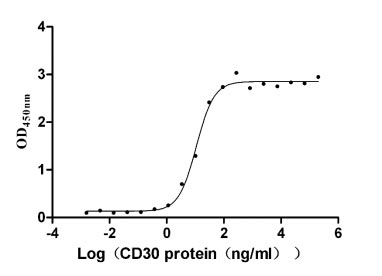
-AC1.jpg)
